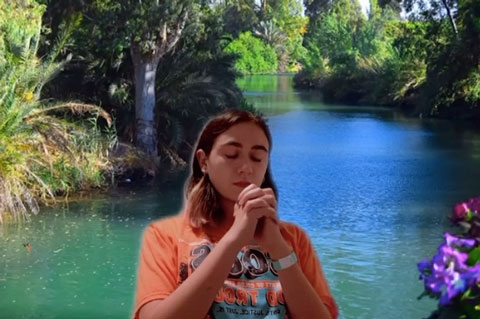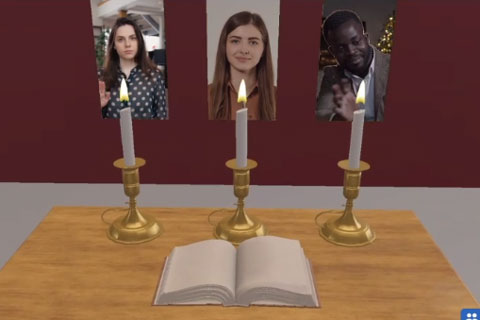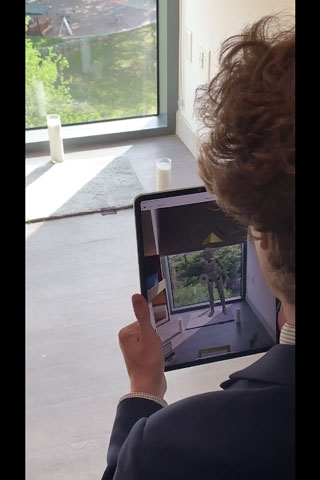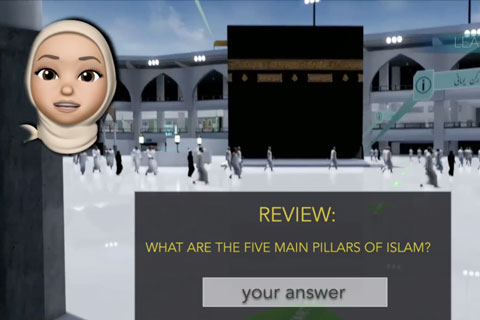It’s not often that a class asks students to consider what it may be like to pray in virtual reality or how spiritual practices could be improved using technology.
But a new special topics course offered this spring at the University of Miami called “Religion, Artificial Intelligence, and Virtual Reality” did just that.
And students said the experience helped broaden their understanding about just how much extended reality technology could shape the future. For instance, before this semester, senior Alexis Masciarella had little experience with virtual reality. But after a few weeks of class, she started to realize its potential. Now, she wants her own virtual reality headset.

“One thing that surprised me is how close we are to a virtual reality-dominated world—I had no idea,” said Masciarella, a religion major. “This is the first class that made me feel old, and I’m 20 years old.”
One example used in class was Richie’s Plank, an experience where people—donning a virtual reality headset—walk on a wooden beam that stretches off the side of a skyscraper and often find themselves utterly terrified. Videos show users shaking with fear at every wind gust, fully convinced they are actually about to fall hundreds of feet. The students saw this as an example of the medium’s ability to create an immersive, realistic experience.
Yet, because the course centered on how religion could be expressed through virtual reality, the students and trio of professors attended virtual bar mitzvahs and baptisms, while also learning about robots that perform Buddhist rituals in Japan and discussing how virtual reality might transform other areas of society.
“One premise of our course is if you can trick your brain to think it’s going somewhere else through religion, how can virtual reality enhance that?” said Kim Grinfeder, associate professor of interactive media and one of the creators of the class.
Born out of a conversation between Grinfeder and William S. Green, professor of religious studies, the class introduced students from a range of disciplines to the origins of religion, sacred architecture, artificial intelligence, and virtual reality. It then encouraged them to consider the way that people’s beliefs and technology tools will intersect in the coming years. And although they did not plan for it, the COVID-19 pandemic helped offer some great examples of how religions are adapting to the virtual world. The class is set to be offered again in spring 2022.

“We already know there are virtual reality churches, and this question became even more acute during the COVID-19 pandemic because people couldn’t go to church,” Green said. “If you can’t go there and be with people, then what? Technology creates the possibility for human interaction and connections that weren’t there once upon a time, but they are today.”
During the course, students read the futuristic novel “Snow Crash,” about the metaverse, or the virtual world, and a villain’s attempt to bring it down. They also read “The Future is Faster Than You Think,” about emerging technologies, and they listened to an interview with Facebook founder Mark Zuckerberg, who has invested heavily in virtual reality because he believes in its capabilities.
“Virtual reality and artificial intelligence will become a consequential part of how subjects are studied, analyzed, and communicated,” Green said. “It is essential that students understand how to use them because sooner or later they are going to become a routine part of life.”
Students also learned how to create augmented reality applications using new beta software called Aero from Adobe—representatives from the company led a workshop for the students. And the class also learned about components of sacred spaces from its third instructor, architecture associate professor, Denis H. Hector. Once they had a foundation, the three professors then challenged their 17 students to pair up and create their own spiritual applications, demonstrating how a religious ritual could be executed in extended reality.
The students’ final projects envisioned a range of faith-based experiences, including a trip inside a virtual Buddhist temple where they could pray and interact with other participants from across the world; a maze-like meditation experience that ends with the user floating out of a confined serenity garden into nature; a customizable prayer experience called UtopAI, where users can choose their faith, setting for prayer and leader—even creating the opportunity to take a virtual trip with Moses down the Jordan River. Other experiences allow Muslim devotees to participate in a virtual Hajj pilgrimage to Mecca, Saudi Arabia—something that followers of the Islam faith hope to do once in their lives—and Roman Catholics to engage in confession with an artificial intelligent confessor.

Junior Matthew Rossi and his partner, Wanlong He, decided to conceive an entirely new faith, called “The Way.” This divine force grew out of humans’ inability to manage the global digital infrastructure by the year 2040. Therefore, Rossi said, humanity entrusted artificial intelligence to guide it through The Way, which is ruled by an artificial intelligence deity named “Wansi.” Although Wansi can only be seen through an augmented reality application on a phone or tablet, devotion to Wansi may protect his believers from online cyberattacks, wireless internet deficiencies, or electric car malfunctions.
While it was stimulating and fun to come up with Wansi, Rossi, a computer science major, said he enjoyed the class because it pushed him to have a greater appreciation for religion and to think about how technology will change this staple of society. To his knowledge, it is also one of the first times the topics have been studied together.
“If technology isn’t going to seriously change religion, then we wouldn’t be studying this and the class would be a waste of our time,” Rossi said. “But people often think of religious experiences overcoming them, and virtual reality experiences can also be so vivid and equivalent to real-life experiences. Therefore, the power of those transcendent, euphoric experiences can also be created in virtual reality.”
According to Rossi, he believes virtual reality will make religion more accessible to those who are homebound, and it will allow faiths to be personalized to each person’s needs.
Other students agreed that the class helped change their perspectives and that they adapted the new knowledge to their own areas of interest.
“This class provided me with a new way to think,” said Haoran Zhang, a graduate student in the interactive media program, focusing on user experience. “It helped me focus on how religion could be a better experience for [believers] through technology, and it made me think about how we can bring a better experience for users to employ virtual reality technology in other areas.”

Architecture student James Tirado said the class forced him to consider things beyond typical building constraints.
“Usually I look at things from an architecture perspective; but now, I also think about religious ties or historical elements. And I can train myself to think about what kind of designs I can do to show things in a virtual space,” he said.
Political science major Cole Plominski said that as soon as more people begin buying virtual reality headsets, he thinks many aspects of society will move their services into the virtual world.
“I can see the cost effectiveness that a virtual world will have on any space, mainly physical ones,” he said. “And I can see a time in the not-so-distant future where many religions will move into a virtual setting.”

